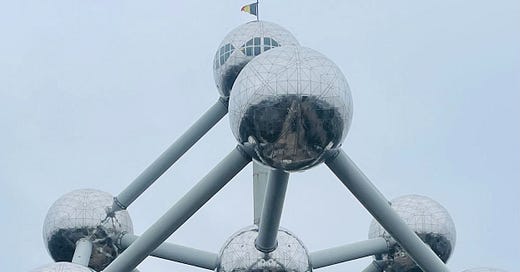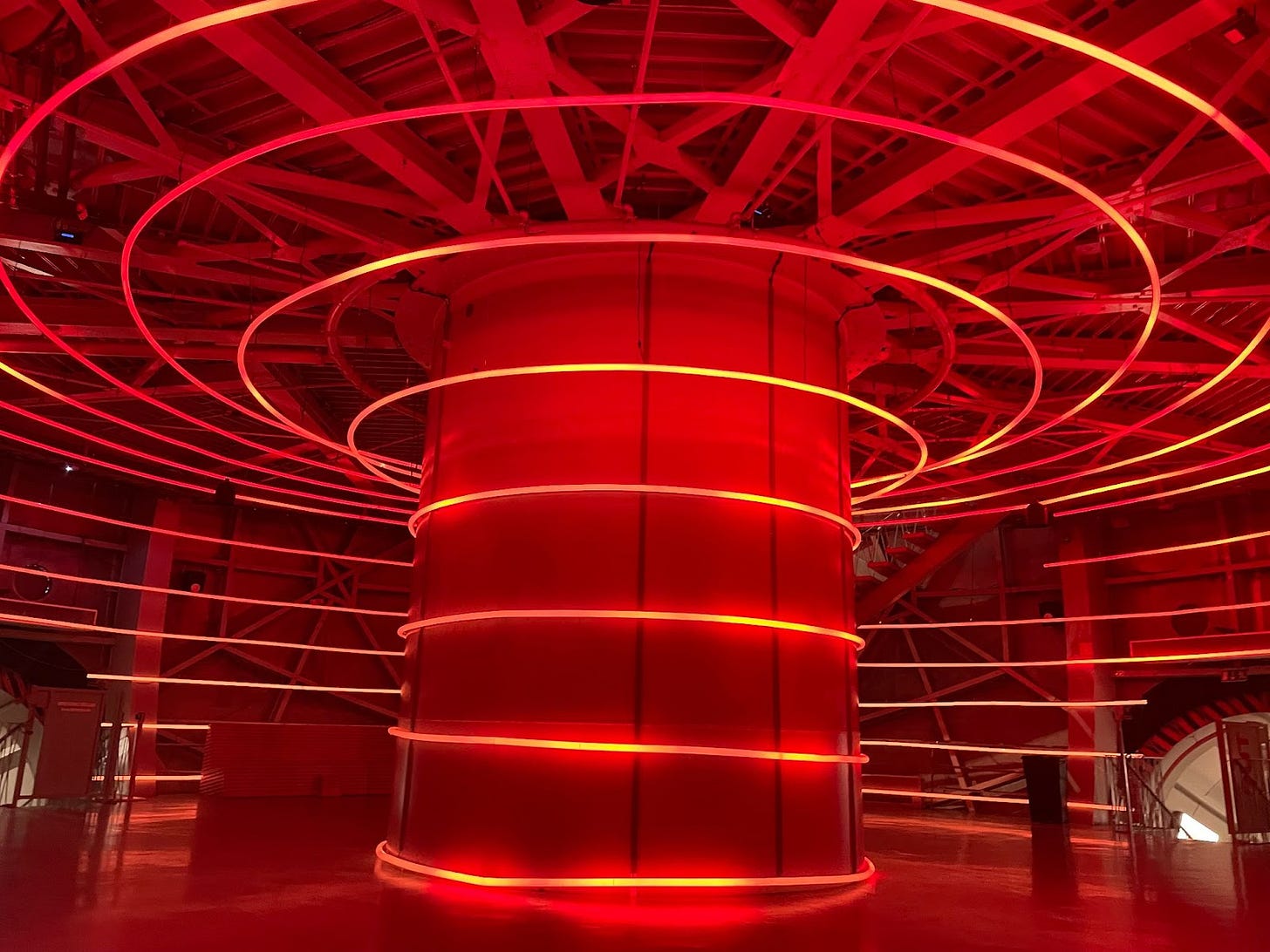“We will make electricity so cheap that only the rich will burn candles” - Thomas Edison
Edison was dreaming big when he said that.
Belgium was dreaming big when they built the Atomium. It took 18 months to design and another 18 months to build.
The Atomium is a 102-metre-tall structure which was constructed to popularise nuclear science and to demonstrate the expertise of the Belgian steel and non-ferrous industry. Since the structure required a lot of aluminium to build as well, the name Atomium is a portmanteau combining the words “atom” and “aluminium”. The structure was completed in 1958.
J'ai vu le futur. “I have seen the future.” These words are displayed inside the structure like a mantra for humankind. It’s not wrong. Consider the structures we admire the most: the Eiffel Tower, the Colosseum, the Pyramids, the Taj Mahal, the Easter Island heads, etc. We do not argue that these structures are too big. We visit them because they are so big, to marvel at their bigness.
For much of human history, we have tried to show our greatness, or to celebrate that which we have believed to be greater than us, through constructing large monuments.
So why are large-scale projects now so heavily criticised?
It may not surprise you that the idea that big is bad came from an anti-growth, anti-technology activist.
E F Schumacher wrote Small is Beautiful: A Study of Economics as if People Mattered in 1973. The book argues in favour of what Schumacher calls small, “appropriate” technologies as a superior alternative to the general ethos of "bigger is better". The latest edition of the book features a foreword by depopulation and degrowth activist Jonathon Porritt.
The book is a holy text for degrowthers, anti-progress activists, and Malthusians alike. It suffers from the recrudescence of the common fallacy of man versus nature, as Schumacher argues that “The system of nature, of which man is a part, tends to be self-balancing, self-adjusting, self-cleansing. Not so with technology.”
This book is a vicious attack on scientific progress, yet in 1995 The Times Literary Supplement ranked Small is Beautiful among the 100 most influential books published since World War II.
Schumacher writes:
“Our scientists and technologists have learned to compound substances unknown to nature. Against many of them, nature is virtually defenceless. There are no natural agents to attack and break them down. It is as if aborigines were suddenly attacked with machine-gun fire: their own bows and arrows are of no avail. These substances, unknown to nature, owe their almost magical effectiveness precisely to nature’s defencelessness – and that accounts also for their dangerous ecological impact. It is only in the last twenty years or so that they have made their appearance in bulk.”
If it’s not clear what technology Schumacher is talking about (since activists have their own spurious definition of the word), consider his arguments against nuclear energy:
“Of all the changes introduced by man into the household of nature, large-scale nuclear fission is undoubtedly the most dangerous and profound. As a result, ionising radiation has become the most serious agent of pollution of the environment and the greatest threat to man’s survival on Earth…. But that nuclear fission represents an incredible, incomparable and unique hazard for human life does not enter any calculation and is never mentioned.”
All of these claims are false.
But the influential Schumacher goes even further. He argues against even learning about the laws of physics:
“What do I miss, as a human being, if I have never heard of the Second Law of Thermodynamics? The answer is: Nothing. And what do I miss by not knowing Shakespeare? Unless I get my understanding from another source, I simply miss my life. Shall we tell our children that one thing is as good as another-- here a bit of knowledge of physics, and there a bit of knowledge of literature? If we do so, the sins of the fathers will be visited upon the children unto the third and fourth generation, because that normally is the time it takes from the birth of an idea to its full maturity when it fills the minds of a new generation and makes them think by it. Science cannot produce ideas by which we could live.”
Consider that last statement. “Science cannot produce ideas by which we could live.” And yet we have heating, lighting, telephones, the Internet, shoes, glasses, clothes, and so on, thanks to science - not Shakespeare (though I take no umbrage with the Bard). The greatest irony of this statement is that we only have books like Schumacher’s and Shakespeare’s thanks to science and technology.
That a prophet of such pessimism and blinkered thinking has influenced our ideas of large-scale technology ought to concern us. While activists argue against large-scale technological projects, note that when they consider the structures to be works of art the same argument is seldom made. For example, the construction of the Sagrada Família, the largest unfinished Catholic church in the world, began in 1882 and continues to this day. For the most part, people do not cry “it’s too big!” or “what about the cost?!” regarding the church. They allow it to be built. They want to see it finished. Similarly, the Notre-Dame is being rapidly rebuilt after it caught fire in 2019.
Schumacher argues that “Wisdom demands a new orientation of science and technology toward the organic, the gentle, the elegant and beautiful.” This premise is based on his belief that some forms of technology are bad, while others are good. But beauty is in the eye of the beholder, and, as I once argued live on French television, we should treat closed nuclear power stations as national monuments. Why not? They represent overcoming poverty. They represent cleaner air, warm homes, lit streets, schools and hospitals. To me, these power plants are the pinnacle of beauty and elegance, for they demonstrate what humankind can achieve when we work together and when we have a shared vision to create a better future for our kin and beyond. They represent the best of us. Sure, the Sagrada Família is beautiful in a more aesthetic way, but whoever decided that we can have one but not the other? That prophet of doom, Schumacher.
The fact is that we need one - power plants - to have the other - the Sagrada Família, Notre-Dame, etc.
Back to the Atomium. With this single structure, Belgium depicted its love of physics through art. The country wanted to highlight and promote the post-war ideal of peacefully applying atomic research and other advancements in technology, and with over 600,000 visitors per year, the Atomium has achieved this aim.
Thanks to Schumacher’s ideology, the beauty of the scientific optimism and vision of the 1950s was displaced by the “small is beautiful” ethos of the 1970s, so it should come as no surprise that Belgium, home of the Atomium and once-proud enthusiast of nuclear advancement, announced in 2003 that it would phase out all of its nuclear power plants. This will have a significant toll on people and the planet since Belgium's nuclear reactors generate around half of the country's electricity.
Thankfully, following the energy crisis, reason prevailed and Belgium decided to extend their existing reactors temporarily. However, Belgium’s nuclear phase-out, though delayed, remains in place. Will Belgium ever return to its roots, which are so clearly depicted by the technical feat that was the construction of the Atomium? A colossus of ingenuity and vision looms large over the country, posing this question.
While there are valid arguments for making things smaller for practical reasons like reducing cost or transporting them more easily, we must not abandon thinking big and building big based on the lie that small is always beautiful.
Schumacher and I do agree on one thing. He wrote: “To talk about the future is useful only if it leads to action now.” Indeed, we should act now and start building. Large-scale nuclear energy is needed to displace fossil fuels, and committing to it represents the veriest foresight. Without new power plants, we cannot hope to overcome the vicissitudes of tomorrow and maintain the progress that led us here, and beyond. Sometimes we need to dream big and build big. Or, to put it less elegantly, we should go big or go home.








A very well-thought out piece about the significance of scale. I agree entirely with everything you wrote about Schumacher. His is essentially an ode of praise to poverty, malnutrition, starvation and premature death. Neither he nor any of the other "degrowth" advocates have any real idea of the true horror of life lived without technology. Life in a state of nature was summarized quite accurately by Thomas Hobbes as "nasty, brutish and short."
All of the degrowth advocates would not much like if they were compelled to live in a world with no modern medicine, no food supply preserved by modern technology such as refrigeration, no modern transportation systems to ship food across large distances to where it is need. Even more, they would dislike a world with no effective electricity systems powering the machinery by which they dispense their opinions via computers, telephones or mass audio and video systems. As such then, the degrowth advocates are a pure form of nihilism, wishing themselves and human technology out of existence.
They are of course free to believe whatever they wish to believe. But they must not be free to inflict their wishes on others who do not share their delusions. In short, the Club of Rome should be forced to live in the world they strive towards. We would then see its advocates fleeing frantically in all directions.
Great work. This 'small is beautiful' ideology is definitely a product of the 1970s and a rejection of 50s and 60s science/engineering optimism. It goes hand in hand with Amory Lovins and his 'soft path' towards new energy systems (i.e, renewables). Renewables are now part of the 'distributed energy' crowd, who totally buy small is beautiful and often talk about the 'democratization' of energy. Its mostly BS. Big is actually beautiful, and economies of scale are REAL. Its interesting to note that large aircraft (think 747) used to have four engines, but when larger engines were developed, the same size of aircraft employed them and many large aircraft today only use two engines. Why? It turns out that the new engines have acceptable reliability and using two engines vs four is SIMPLER, cheaper and lighter in the long run. So the trend in aircraft propulsion has really been that Bigger is Better.